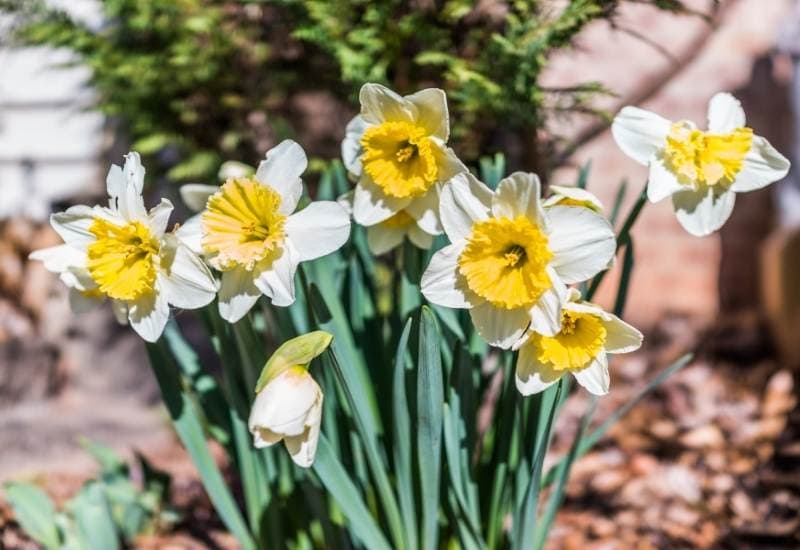
Daffodil is a very popular genus of bulbous flowers with at least 50 natural recorded species. But we estimate that there are over 13,000 varieties of including the many cultivars and hybrids. Daffodils are characterized by a central “cup” or “crown” called corona and six outer tepals, and they are related to amaryllis.
The best way to distinguish them is by size, shape of the flower and color of the flowers. But it is with the flower shapes that we can divide daffodil varieties into 12 groups:
1. Poet’s daffodil
2. Long cup or trumpet
3. Large cup
4. Small cup
5. Double
6. Petticoat daffodils
7. Angel’s tears daffodils
8. Bunch flowered
9. Jonquil
10. Miniature daffodils
11. Tazetta
12. Split corona
Stay with us to learn how to distinguish all the different types of daffodils there are.
How To Grow And Take Care Of Daffodils
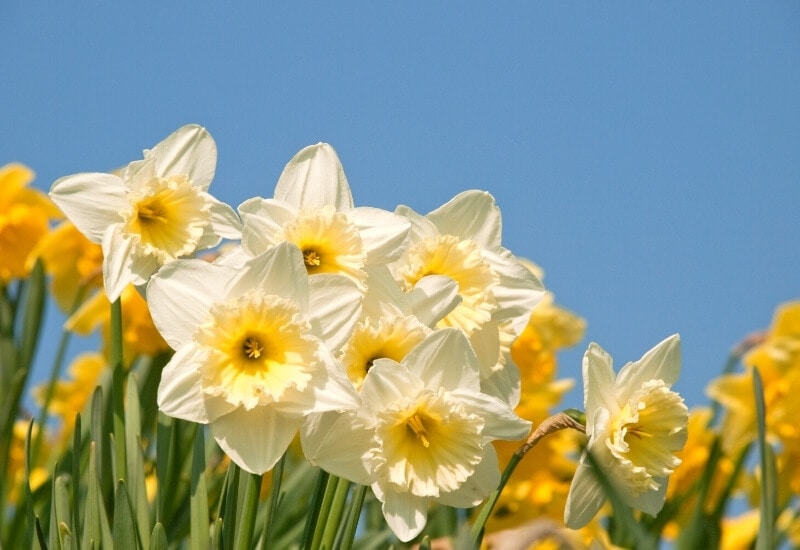
Whichever category you choose, there are some general needs all daffodils have. So, we are going to see them together right now. These have yo do with light, watering, soil conditions etc.
And now we can finally start our journey in the world of daffodil varieties
12 Daffodil varieties
Here are 12 daffodil varieties to consider for your spring garden.
1. Poet’s Daffodil (Narcissus Poeticus)
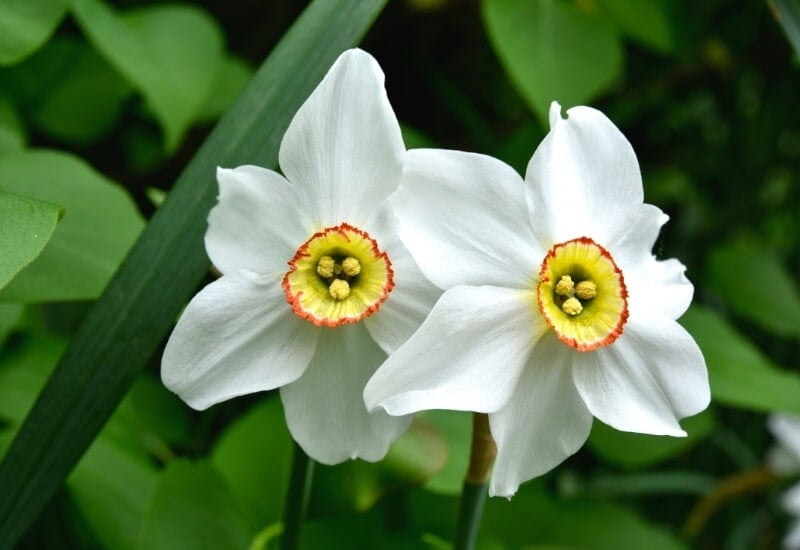
Poet’s daffodil is actually a natural species. You can recognize it because it has a very small and short light yellow and orange corona and white petals. It is fairly short but very classical looking. Above all, however, it has an amazingly beautiful and strong scent.
In fact, this is the “daffodil of the ancient people”, the one mentioned by Greek poets… So you understand its name.
Even if it is native of Europe and the Mediterranean Basin, it has become naturalized in many parts of North America, where it grows spontaneous in wild prairies and even at ten edges of woods.
It is also particularly poisonous, more than other daffodils. But this makes it useful to medicine too…
Gardening Presence And Uses Of Poet’s Daffodil
It is an excellent flower for natural, wild and traditional looking gardens.
It is also a great choice to bring a lawn to life with flowers in the spring. In fact, it will stay underground most of the time, and only take up your green lawn space in the spring. Then, you can safely walk on the lawn and it will come back next year.
It forms beautiful clumps that make it ideal also for pots and containers or in rock gardens.
Finally, it is a good addition to wild meadows and prairies.
2. Long Cup Or Trumpet Daffodils
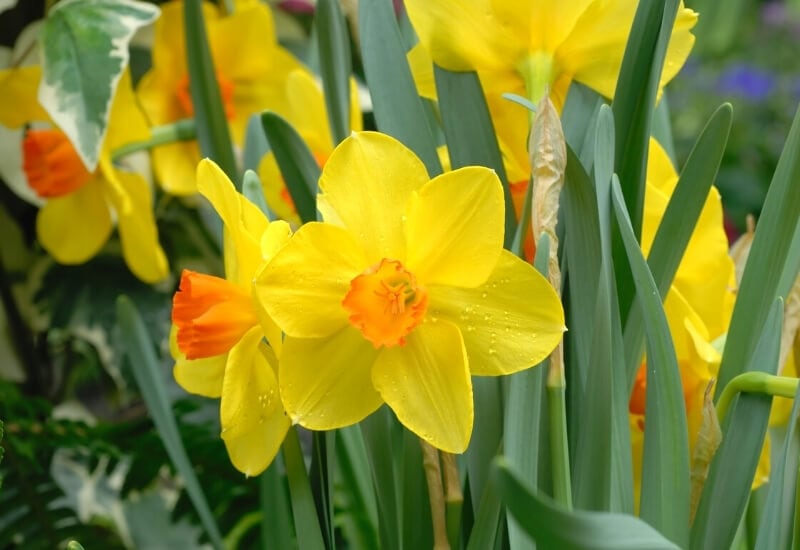
Long cup daffodils are very common indeed, with their trumpet shaped corona. The corona needs to be as long or longer than the outer tepals. They often have large blooms with very bright and decided colors.
mThe flowers can even reach 4 inches (10 cm) across in some cultivars like ‘Dutch Master’. This bright yellow long cup daffodil is one of the most common all over the world, and it has won the Award of Garden Merit by the Royal Horticultural Society and many other awards.
They are usually either white or yellow thought there are some other hues these daffodils can give, on the orange side. They are strongly scented and their profusion of flowers gives that “sea of color and light” effect that we associate with this beautiful flower…
Gardening Presence And Uses Of Long Cup Daffodils
They are excellent for strong and large visual effects. When they are in bloom, in fact, they capture everybody’s attention with their profusion of bright flowers.
For this reason, they are arguably the most common in urban parks and large parks.
They look less wild and more “developed cultivar” than poet’s daffodil, but they still look natural enough to contribute to traditional gardens, in beds and borders alike.
They are excellent to coast shrubs and groups of tree, or to bring vibrant energy into a lawn once a year.
They are also good for pots and containers.
3. Large Cup Daffodils
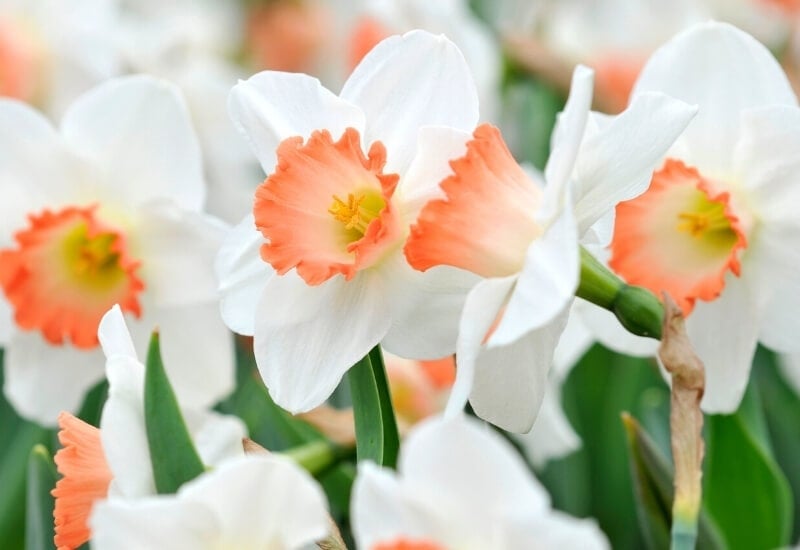
Large cup daffodils have coronas that are longer than one third of the petals, bit less than the length of the petals themselves. Yes, it is that precise! Otherwise they become long cup,mor trumpet…
There is a reason for all this: it is the harmony of the proportions within the flowers really changes their look and presence.
Large cup daffodils often have coronas of a different color from the outer tepals, and I hey are also very famous for having a very special color indeed: pink!
Gardening Presence And Uses Of Large Cup Daffodils
Large cup daffodils are very wide in range of appearance. Some are totally yellow and have longish coronas, others are more similar to a small cup daffodil with the corona of a different color from the rest of the flower.
The larger, monochrome varieties are better for wide and striking color and visual effects, a bit like trumpet daffodils.
The shorter ones, and those with two colors are better in natural looking borders or beds.
Containers and pots are also a good place to grow them.
4. Small Cup Daffodils
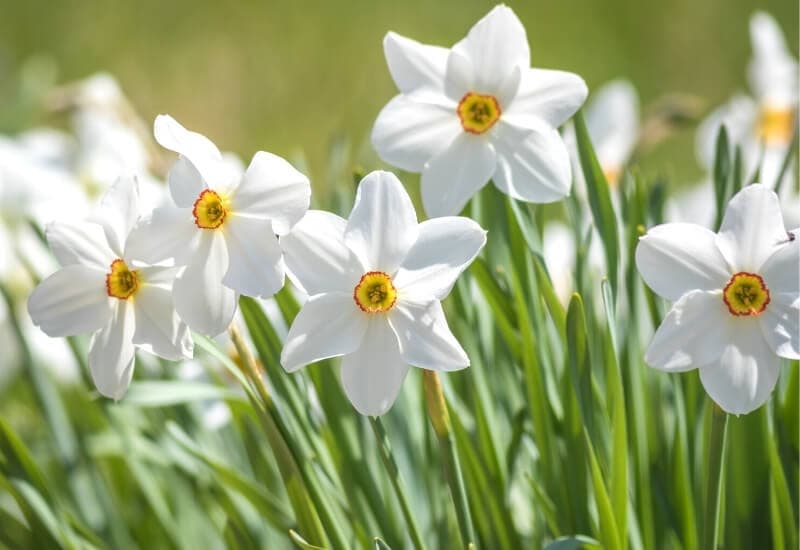
Small cup daffodils look a bit like a cross between the trumpet varieties and poet’s daffodil, They have larger coronas than poet’s daffodil, and the 6 sepals are fairly large and often rounded.
The coronas are usually a different color from the outer sepals, often orange or a mix of orange and yellow.
Small cupped daffodils have short but fairly large coronas therefore. Nevertheless, it stands out thanks ti its different coloring.
They are a very popular type of daffodils too, and you can find them in many gardens and every garden center.
Gardening Presence And Uses Of Small Cupped Daffodils
Small cupped daffodils will not give you the same striking general effect as trumpet daffodils. On the other hand, they are more showy than poet’s daffodils. While the overall effect is great as well, these flowers give their best when you can also loom at them close by.
So, don’t plant them far away at the end of a big lawn at the back of your garden…
They are better suited for flower beds, borders and pots and containers. They are also excellent for wild prairies, but patios and terraces too.
5. Double Daffodils
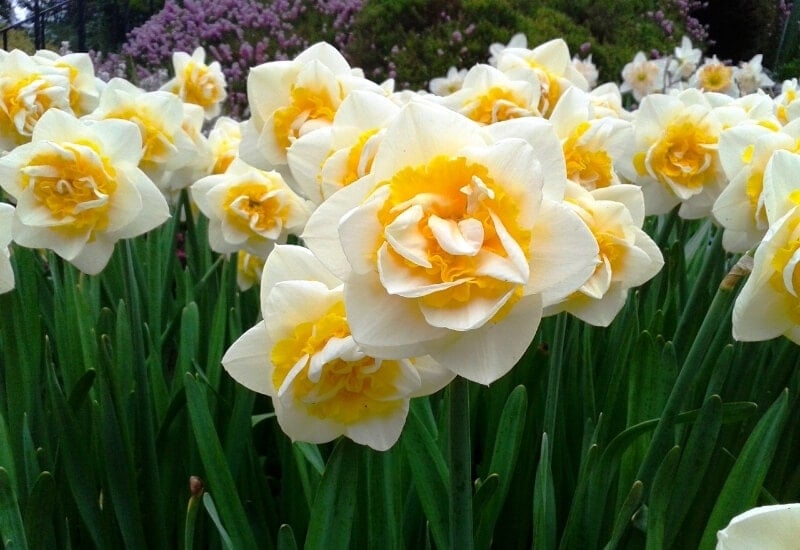
Double daffodils are easy to identify because the corona is a series of petals, not single, but in fact double. They are all cultivars, as they do not exist in Nature and they were developed by gardeners over the decades.
The colors range from pure white to white and yellow, white and orange and orange and yellow.
Gardening Presence And Uses Of Double Daffodils
Double daffodils look more “exotic” and less natural than all other daffodils. This limits their uses…
While you can still use them in a natural looking garden, they may look a bit out of place in a strongly traditional setting or in a wild looking composition.
They will look particularly good in pots and containers, but also in flower beds.
The gardening world is divided about double daffodils with some gardeners “not being fans” of them.
6. Petticoat Daffodils (Narcissus Bulbocodium)
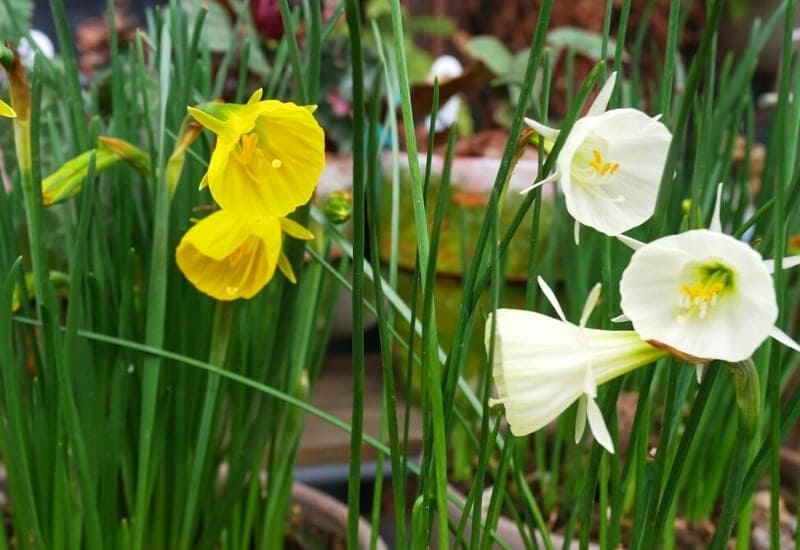
Petticoat daffodils are very elegant… These flowers have a large, funnel shaped corona and very thin outer tepals, that look like slender rays… In this, they are some of the most original looking daffodils you can find.
However, the flowers are small, about ½ inch (1.2 cm), the smallest of all daffodils in fact!
And they are not “man bred”! No, this is a natural species native of the Western Mediterranean (France, Spain, Portugal and Morocco). However, men have developed some interesting cultivars and hybrids, especially playing with the colors.
Garden Presence And Uses Of Petticoat Daffodils
Petticoat daffodils look very delicate and they are quite small. This means that you want to have them at close range, where your visitors can see them close by.
They also do not have such generous blooms and trumpet daffodils.
They are excellent for low beds and especially for rock gardens.
They will also look great in containers and pots, gravel gardens and even formal settings.
7. Angel’s Tears Daffodil (Narcisssus Triandrus)
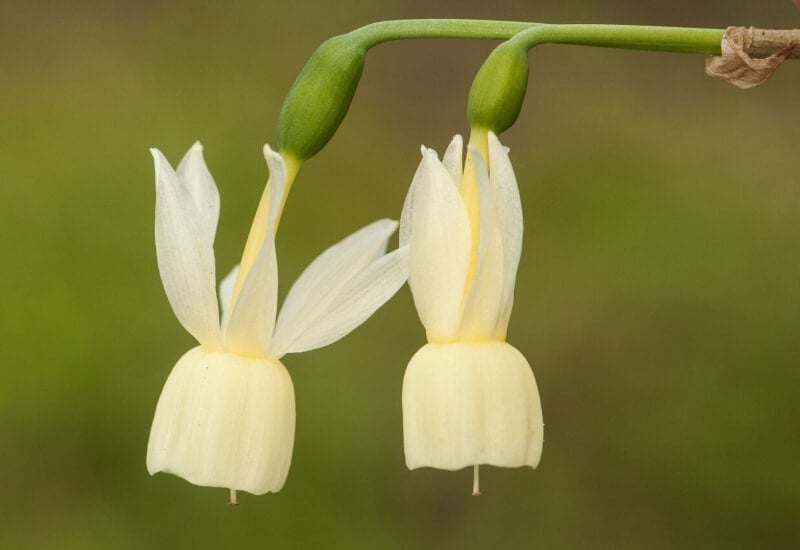
Angel’s tear daffodils are very original looking, sweet and delicate. You will recognize the, because the flowers are nodding – they look down – with a soft looking, lantern shaped corona and the six outer tepals turn upwards. This gives them a unique, dynamic but also very balanced look.
This too is a natural species, like petticoat daffodils. And angel’s tears daffodils too come from the Western Mediterranean. It must be a special place for original looking daffodils.
The size of the flowers varies according to how north or south this plant grows… They are bigger in the north and smaller in the south… This seems to depend on the size of the pollinators, which are bigger in the north…
The color is either white cream or bright yellow.
Garden Presence And Uses Of Angel’s Tears Daffodils
These are very delicate looking flowers, with an original and somewhat exotic shape.
They will look their best in full view, in containers, pots, well kept and uncluttered low flower beds…
They are also excellent for gravel and urban gardens, even with a modern or minimalist feel.
My favorite place, however, would be in rock gardens.
8. Bunch Flowered Daffodils
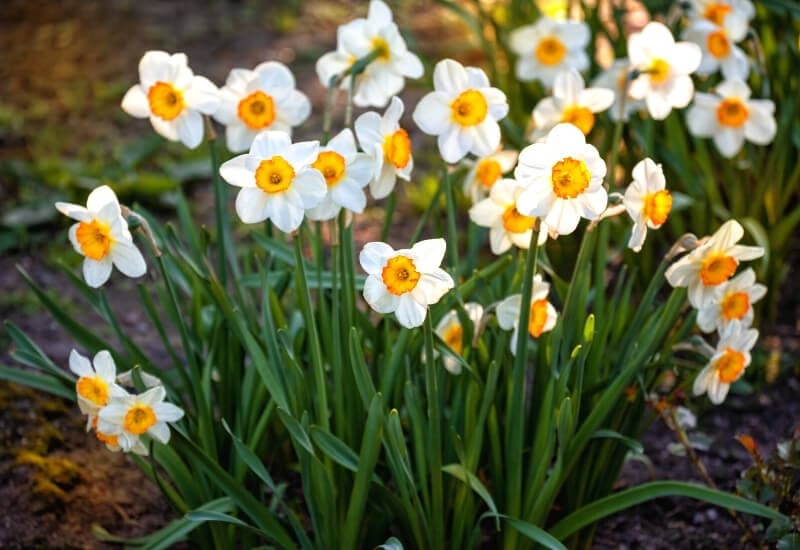
Bunch flowered daffodils have more than one flower at the end of each stem. It’s a cross category of different shaped daffodils that produce groups of flowers instead of single heads.
Having said this, they are not usually large flowers (like trumpet daffodils). The presence of three or more flowers on the same stem changes the overall effect. In fact, daffodils are very regular with the height of the flower heads. The final visual effect is that of a dense but even carpet of colors…
Bunch flowered daffodils add a deeper layer of flowers, which can be a great asset to gardeners, as we shall see next.
Gardening Presence And Uses Of Bunch Flowered Daffodils
Because of the thicker layer of flowers they produce, they are excellent to add depth and to borders and flower beds. The “flower range” will be much larger than with single stem flowers. You don’t want your borders and beds to look like a “green mass with flowers just on the surface”…
Because the different flower heads are quite close by, you can also use them to “fill in” empty beds and borders that lack color and bloom.
They will also look great in containers and pots, if you want to grow them there.
They are not very suitable to formal settings.
9. Jonquil
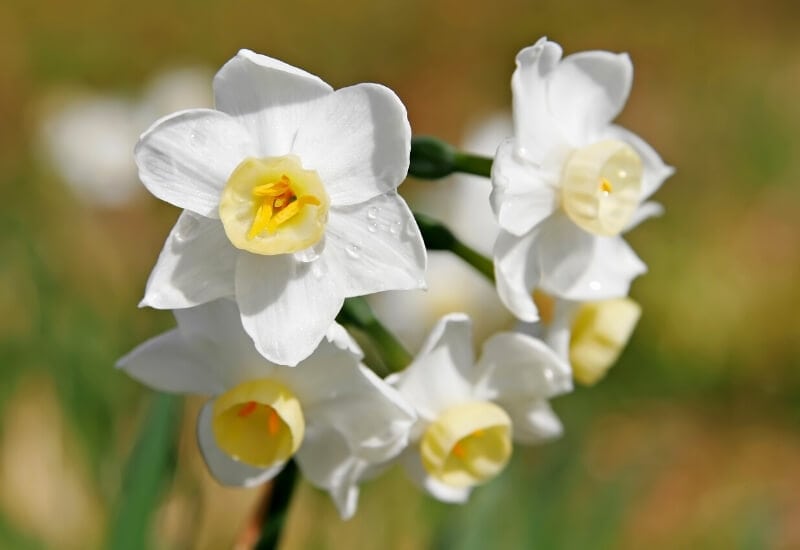
Jonquil or jonquillia is a type of narcissus with small flowers but also small and open cups. The corona of this type of daffodils opens at the tip and it is usually of the same length as the outer tepals.
This makes it a very balanced and harmonious looking flower.
They can be monochrome or of two different colors. As usual, the corona will be darker than the outer tepals. Jonquils too have that special color that very few daffodils have… That light and delicate pink that so many of us love.
Finally, jonquils have very strong and pleasant aromas.
Gardening Presence And Uses Of Jonquils
Jonquils are very elegant flowers, very harmonious and natural looking. The flower heads are not big, so they are excellent for large but delicate effects or as flowers to admire at close range.
Instead of a sea of monochromatic flowers, with jonquils you can create “dappled effect” if you grow them in large patches at the back of lawns…
At close range you can literally use them in all informal settings. Plant them in borders or bed, wild meadows or containers and you will not be disappointed.
10. Miniature Daffodils (Narcissus Cyclamineus)
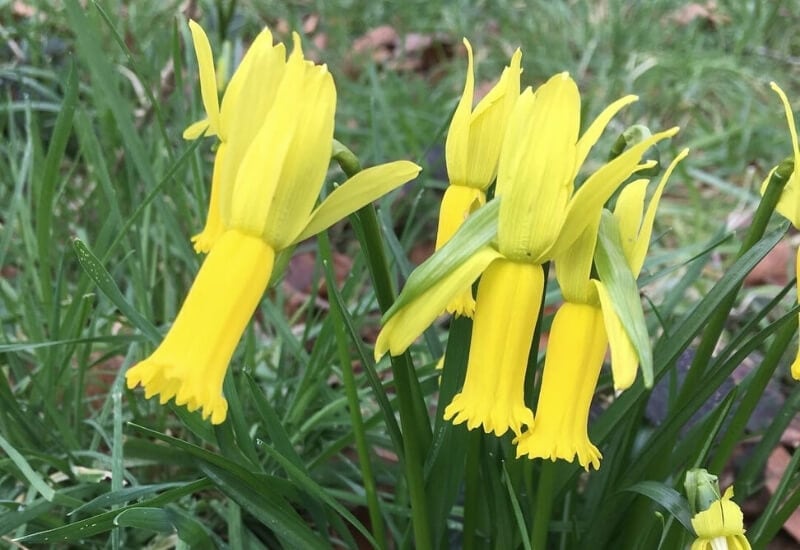
Miniature daffodils have one flower per stem with relaxed six outer tepals, which means pulled back. They can be slightly pulled back or totally turned backwards. The flowers are pendent, or drooping. Thus the term “cyclamineous” because they look like cyclamens.
They are very elegant and light in appearance and often all the flowers of a clump or group look in the same direction. This makes them very attractive, harmonic, almost neoclassical.
Both the flowers and the plants are small. Each head will reach about 2 inches in length (5 cm) and the plants never taller than 8 inches (20 cm).
This oddly shaped variety too is a natural species from the Western Mediterranean, as it is native to North West Spain and Northern Portugal.
Gardening Presence And Uses Of Miniature Daffodils
Miniature daffodils need to go in a clearly visible spot, given their small but very delicate and decorative presence. At a distance, in a big lawn, you will be wasting most of the effect of these flowers.
In low, tidy and not overgrown flowerbeds they will look great. But they look best in beds where there is some space between the different plants, clumps and groups.
They are terrific for rock gardens but given their interesting shape, gravel gardens and even gardens with a modern look may be good for them.
Finally, they are wonderful in small containers and pots.
11. Tazetta Daffodils
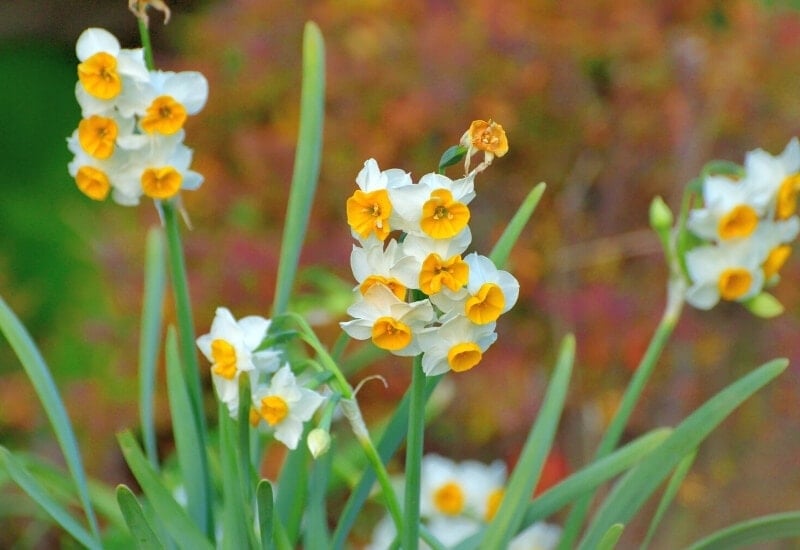
Tazetta daffodils have short cupped flowers and they are from medium to small in size. But what makes them special is that each stem will produce between 3 and 20 flower heads.
The most popular varieties have coronas of different colors from the outer tepals, but this is not a must. Yet again, the most common color combination is white with an orange corona.
They are very sweet looking and attractive, though not as showy as trumpet daffodils. In many cases they may look like poet’s daffodils but with inflorescences rather than single flower heads.
Gardening Presence And Uses Of Tazetta Daffodils
Tazetta daffodils are “cute looking” flowers, with many heads that work together to give a very pleasant, spring like but even “childish” effect. In the sense that they will remind you of your childhood, its innocence and its joyous spring days…
They will be great as part of flower beds, small ones in particular, but also mixed in with low borders and wild meadows.
In pots and containers they will also look good, especially in small ones.
12. Split Corona Daffodils
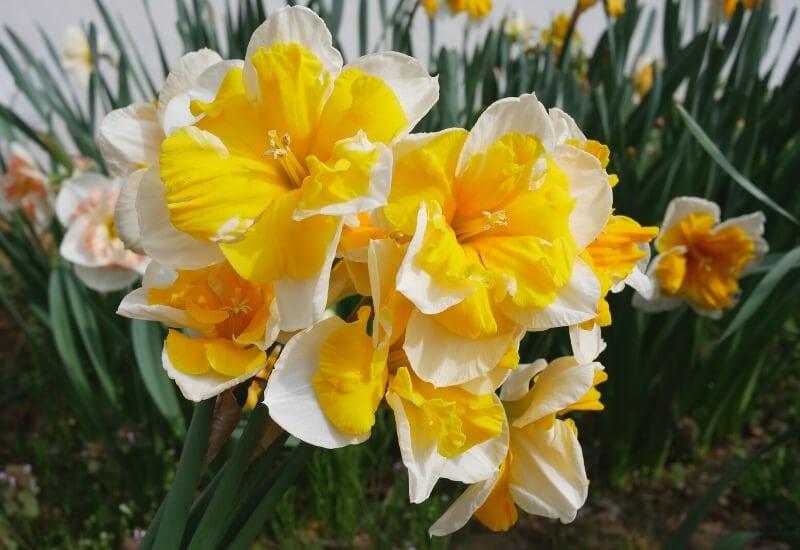
Split corona daffodils are different from other types because the corona, instead of being whole, is cut into a series of petals. They are all cultivars of course, and they are “on the way to double flowers but not yet there” in a way.
The split coronas can be frilly or smooth. They are often of a different color from the outer tepals, but not necessarily.
They tend to have large flowers and bloom a bit later than other daffodils, in late spring.
Presence And Gardening Uses Of Split Corona Daffodils
Split corona daffodils are not suitable to natural looking and wild looking gardens. They look too “garden center” to fit in those contexts.
But they will look great in flower beds and borders with other showy flowers in most other contexts, including in formal gardens.
But maybe their best place is in a focal position of your garden or terrace, maybe by a nice feature or coasting a viewpoint, even in pots or containers.
Daffodils – Not One But a Thousand Flowers!
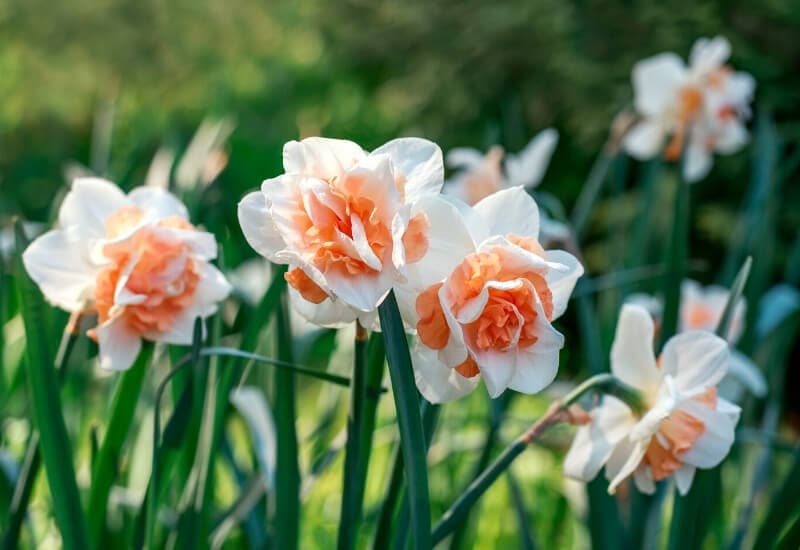
Did I mention that daffodils are the most common bulbous flowers in the world after tulips? Yes, they are one of the most popular flowers ever! With their great smell, beautiful and original flowers… the fact that they are so easy to grow and naturalize, I am sure you understand why…
But now you also know that there are so many types that you really have a wide choice, for different settings and different effects.

Written By
Adriano Bulla
After many years as an academic in London, Adriano Bulla became a writer, publishing books like A History of Gardening, Organic Gardening and Elements of Garden Design; he then decided to become a gardener, following his childhood dream, and has been following his dream writing and gardening professionally in Southern Europe, where he has specialized in new and innovative organic gardening fields and techniques, like permaculture, regenerative agriculture, food forests and hydroponics.
